WinfrGUI Software – Recover Permanently Deleted Files in Windows 10/11
Windows File Recovery can be difficult via the command line, so Microsoft created WinfrGUI software to simplify the process.
WinfrGUI is a free Windows file recovery utility with a graphical user interface (GUI). It’s designed to recover deleted or lost files from various storage devices and supports multiple file systems.
We will learn what WinfrGUI software is and how you can use it to recover deleted files on your Windows 10/11 device.
Table of Contents
WinfrGUI Software:


Free
What We Like:
- User-friendly interface with minimal options.
- It can recover a wide range of file types, including media files, office files, and ZIP files.
- It supports two scan modes - Quick scan and Deep scan.
- CLI is compatible with both slow and high-speed processors.
- WinfrGUI is a 100% free tool.
- It is designed with advanced file recovery technology, offering a high recovery rate.
What We Don't Like:
- Support only Supports Windows 10/11, NTFS/FAT/exFAT/ReFS.
- Limited functionalities compared to other data recovery tools.
- The deep scan doesn't preserve the folder structures and file names.
Use Cases for WinfrGUI Software:
- WinfrGUI is ideal for recovering accidentally deleted files, formatted drives, or data lost due to system crashes.
- Supports recovery from SSDs, HDDs, USB devices, and memory cards across various file systems like NTFS, FAT, exFAT, and ReFS on Windows 11/10.
What is WinfrGUI Software?
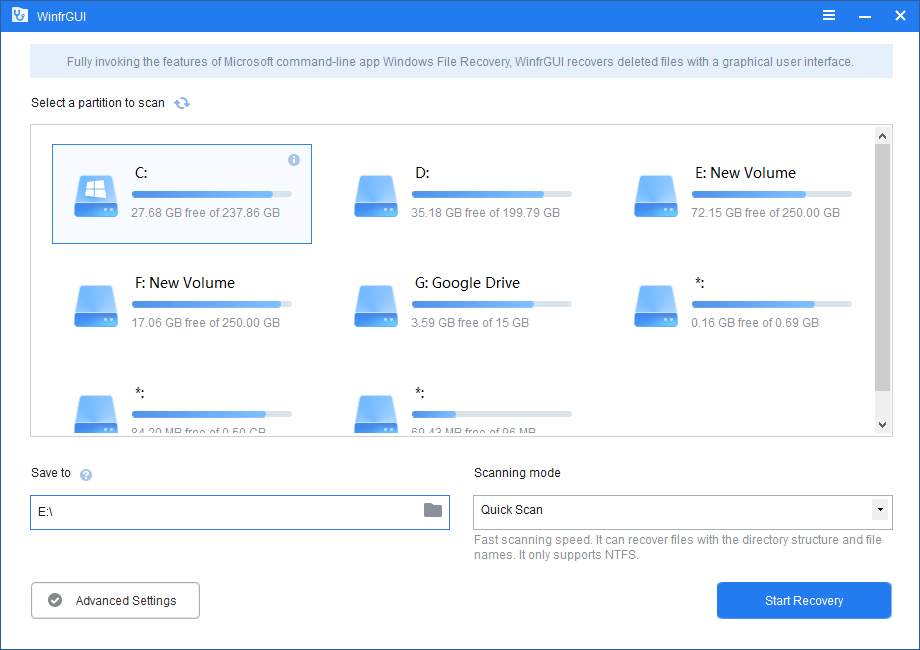
WinfrGUI, which means Winfree GUI, is the best free data recovery software that fully utilises Windows file recovery while allowing anyone to recover or pick erased and missing files from their PC. AOMEI is a renowned company that deals with data recovery and backup solutions, and it released its product WinfrGui in December of 2021.
WinfrGUI supports two scan modes: quick scan and deep scan. Under the NTFS file system, a quick scan can retrieve files with directory structures and their names, while the deep scan retrieves more files without any directory structures and names.
Understanding Data Recovery
Data recovery is retrieving lost, deleted, or inaccessible files from storage devices. Users can accidentally delete, format, corrupt, or lose these files for various reasons, such as software crashes, hardware malfunctions, or even virus attacks.
Here are some common data loss scenarios where data recovery software like WinfrGUI can be helpful:
- Accidental deletion: We have all done it: hit the delete button too quickly and lose crucial documents, photos, or videos.
- Formatting: Sometimes, formatting a drive is necessary, but it erases all existing data. WinfrGUI could recover some of that data.
- Corrupted files: File corruption may cause many problems, ultimately preventing you from using the files. Data recovery software can try to override the counterfeit files.
- Lost partitions: Partition issues can sometimes make data inaccessible. WinfrGUI might be able to recover data from lost partitions.
However, it’s essential to understand that data recovery is only sometimes successful. The chances of recovering your files depend on various factors, like when you deleted them and whether new data has overwritten them.
How To Recover Permanently Deleted Files Using WinfrGUI Software?
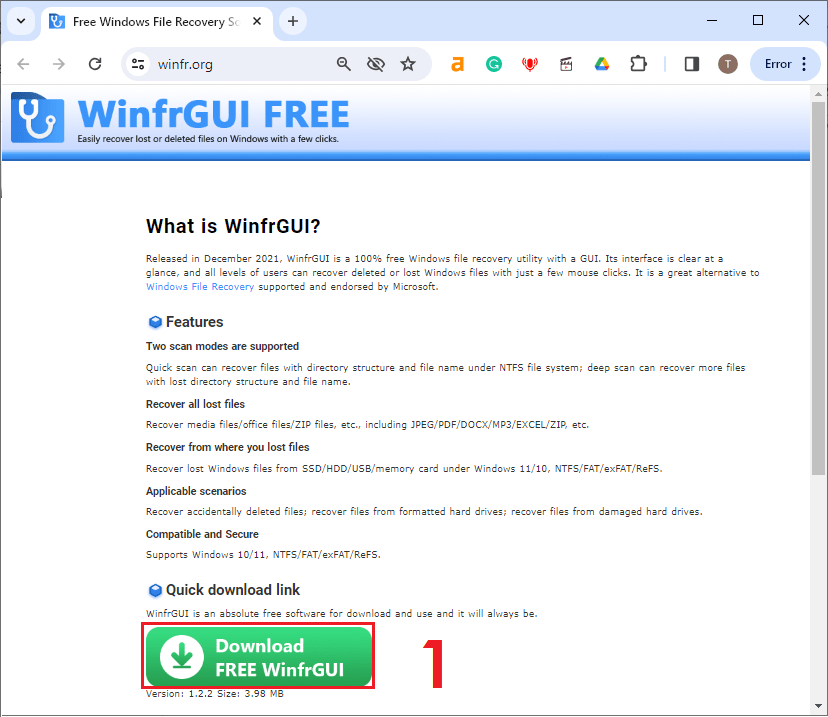
1. You can download WinfrGUI from its official website. After downloading, install the software on your computer.
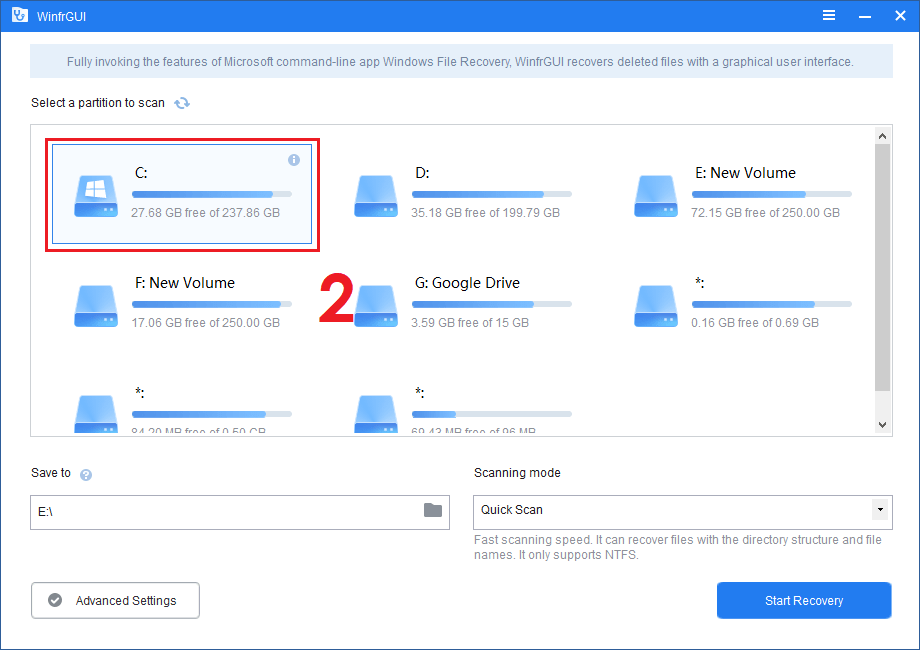
2. Open the WinfrGUI software. The interface is user-friendly and self-explanatory. Choose the partition or drive where your deleted files were originally located.
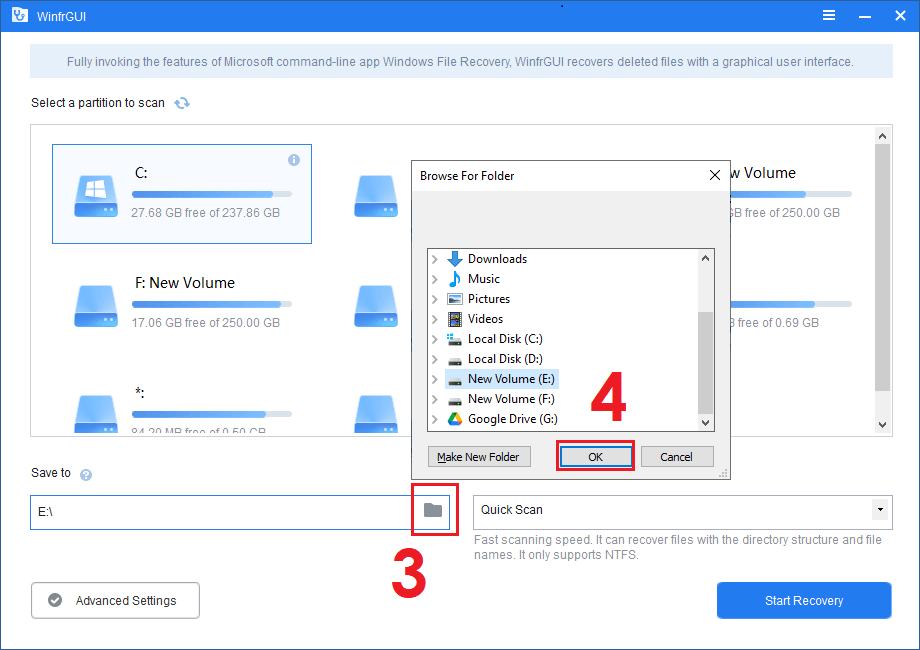
3. Click on the Folder icon
4. Select a different location to store the recovered files. Please note that the recovery folder cannot be the same as the scanned drive or partition.
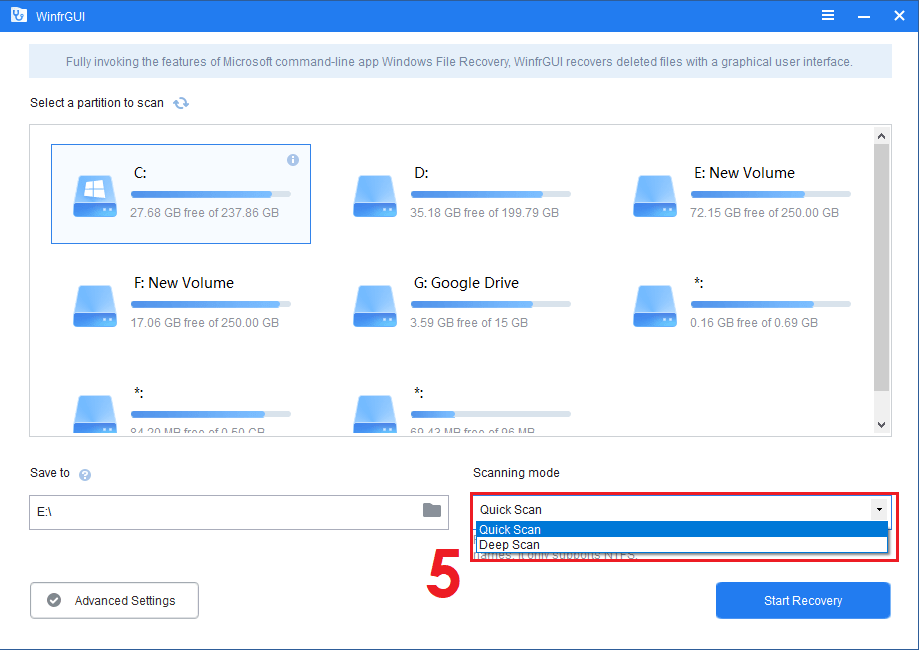
5. Select the scanning mode.
WinfrGUI offers two scanning methods – Quick Scan and Deep Scan. Quick Scan is faster and supports the NTFS file system, helping to find files that have file names and directory structures. Deep Scan can recover more files that have lost their directory structure and file names.
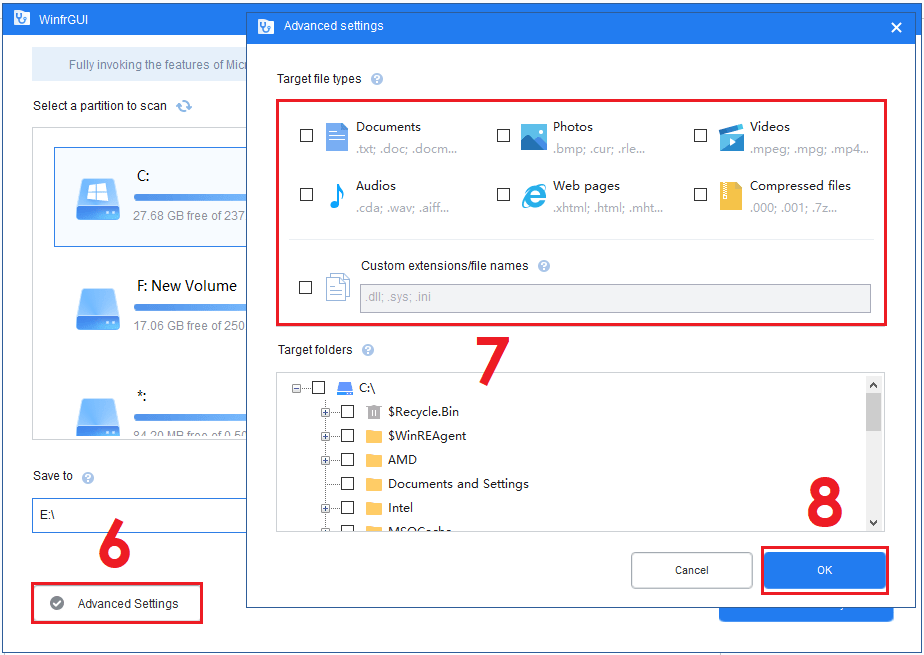
6. Click on the Advance Settings
7. If you want to recover a particular file type or file name, you can select the required setting here. Otherwise, leave it as default.
8. Click OK
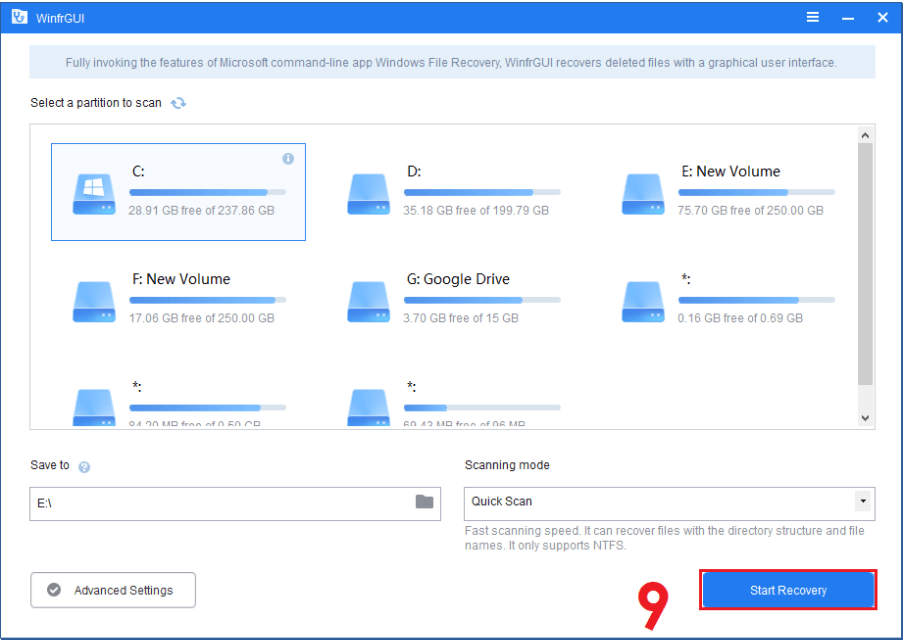
9. After setting up everything, click the “Start Recovery” button.

10. Click on the View Recovered Files button
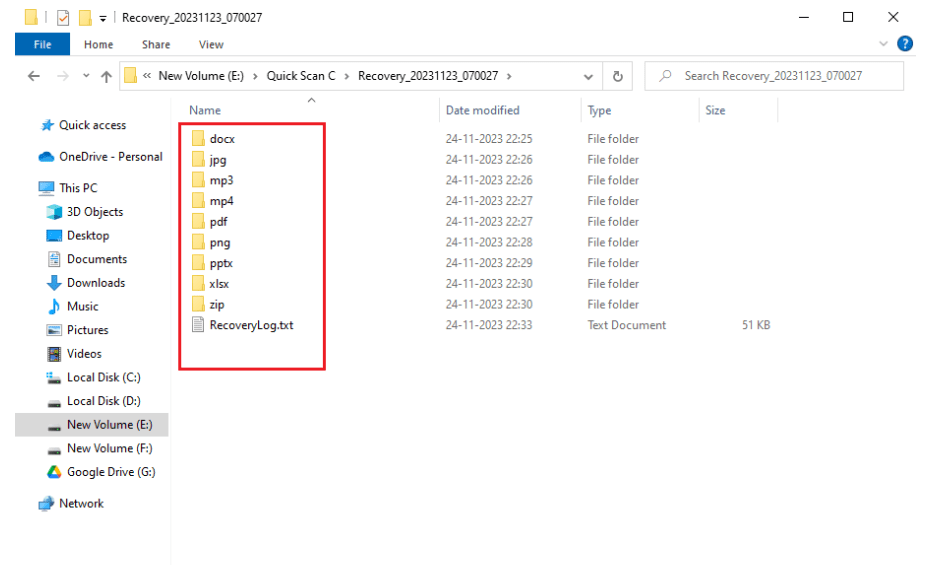
11. Here, you can see the list of folders; as the name suggests, you can find the respective files like documents, jpg, mp3, mp4, pdf, png, etc, inside the respective folders.
That’s it! With this software, WinfrGUI, you have just managed to recover your deleted or lost files on Windows 10/11. WinfrGUI is a simple yet helpful utility capable of assisting you in restoring your lost data with the ease of a walk.
What is the Difference Between a Quick Scan and a Deep Scan?
Quick scan is another mode that finds files overwritten by fresh data. It can also save the retrieved files’ original directories and document names. However, a quick scan may only detect some recently deleted files, not those deleted long ago when the disk had formatted. It applies only to the NTFS file system.
The deep scan is slower and, therefore, more thorough. It is possible to recover the files in which new data has been overwritten. In addition, a deep scan searches numerous deleted files that have been deleted for a longer period or when a disk has been formatted. A deep scan is something a quick scan cannot do.
However, deep scan might not maintain the retrieved files’ directory hierarchy and names. Therefore, the software may give common names to the restored files. Deep scan works on all supported file systems.
Can Deleted or Overwritten Data Be Restored?
It also implies that someone may have overwritten the files with new data on the disk. Deleted data leads to an expensive and unsuccessful recovery journey. It means you cannot recover. However, you can recover some or all of your overwritten files using WinfrGUI.
With this, it will be possible to recover overwritten files using the Deep Scan mode of WinfrGUI. The deep scanning mode is better than the quick scan since it will find more deleted files despite having been replaced with some new data.
This method can identify various file types by spanning the disk sector by sector and looking for file signatures. With this approach, the deep scan can restore files that no longer show their folder hierarchy or have lost their specific name.
Therefore, consider extended waits and failure to recover overwritten files via WinfrGUI. Alternatively, you may refrain from using the disc or device after deleting a vital document. It is equally crucial that you do not lose any of your critical information by backing it up frequently enough.
Does WinfrGUI Recover Data From a Bad Disk?
Such assessment may vary depending on the damage caused and the scale. WinfrGUI cannot access and read the disk’s information if your disk has bad sectors or cannot spin up. Therefore, you may be required to seek professional data recovery services or a hardware repair service for this case.
A deep scan will help even if your disk is logically damaged, like a corrupted file system, partition table, or boot sector. The deep scan can circumvent the logical damage and search for the file signature one industry at a time.
On the other hand, the recovery may take some time, and the recovered files may need to contain their proper directory structure or file names.
To recover data on a damaged disk using a WinfrGUI program, you need to verify whether the disk has suffered physical or logical damage in the first place.
For a comprehensive guide on ensuring the safety of your critical data, check out our article on Backup Planning in 2023: The Complete Guide with 10 Essential Tips. It provides insights into effective backup strategies to complement your data recovery efforts.
When to Use WinfrGUI
WinfrGUI is a free and user-friendly data recovery software that’s a good option for several data loss situations, especially for:
- Recently deleted files: If you’ve just deleted a file and haven’t used the drive much since WinfrGUI, there is a high chance of recovering it using the Quick Scan mode.
- Basic data loss scenarios: WinfrGUI is well-suited for common data loss scenarios, such as accidental deletion or basic formatting issues on NTFS file systems.
- Non-technically savvy users: With its graphical user interface and straightforward process, WinfrGUI is a good choice for users uncomfortable with command-line data recovery tools.
However, WinfrGUI might be a better option for some situations. Here are some cases where alternative solutions might be needed:
- Deep data loss or overwritten files: For deeply lost data or files overwritten by new information, WinfrGUI’s Deep Scan mode might not be successful. Consider paid data recovery software that offers more advanced features.
- Physical hardware damage: If your storage device has physical damage, WinfrGUI won’t be able to recover data. You’ll likely need professional data recovery services.
- Complex data loss scenarios: For complex data loss scenarios like lost partitions or RAID recovery, WinfrGUI might not have the necessary functionalities. Consider specialised data recovery software or professional services.
Essential Tips to Increase Recovery Chances
Here are some crucial tips to increase your chances of successfully recovering lost data using WinfrGUI or any other data recovery software:
- Stop using the drive: When you have lost some data, you must shut down the drive immediately, which was affected by the data loss. After using the drive multiple times, you may permanently overwrite the lost files, making them unrecoverable.
- Download WinfrGUI on a separate drive: Don’t download and install WinfrGUI on the same drive where you lost your data. Doing so can overwrite the files you’re trying to recover.
- Try the Quick Scan first: For recently deleted files, start with the Quick Scan mode in WinfrGUI. It’s faster and has a higher chance of success.
- Use Deep Scan only if necessary. It takes longer and might not recover files with their original directory structure. Use it only if Quick Scan fails.
- Backup regularly: A reliable backup procedure is the ultimate remedy for data loss. Back up your crucial files to another device to ensure you still have the records even if you lose the data. Implementing these guidelines will help you increase the odds of successful data recovery using WinfrGUI or other programs. Prevention is always better than treatment.
Following these tips, you can maximise your chances of recovering lost data using WinfrGUI or any other data recovery software. Remember, prevention is always better than cure.
Conclusion
WinfrGUI is an effective and user-friendly solution for recovering permanently deleted files on Windows 10/11. Developed by AOMEI, this free software offers a straightforward process with a graphical interface, making it accessible for users unfamiliar with command line tools.
Supporting various file types, storage devices, and scan modes (Quick Scan and Deep Scan), WinfrGUI provides a versatile recovery solution. While it excels in many scenarios, users should be aware of potential limitations, especially when dealing with overwritten files. Overall, WinfrGUI is a valuable tool for users looking to recover lost data effortlessly on their Windows systems.
